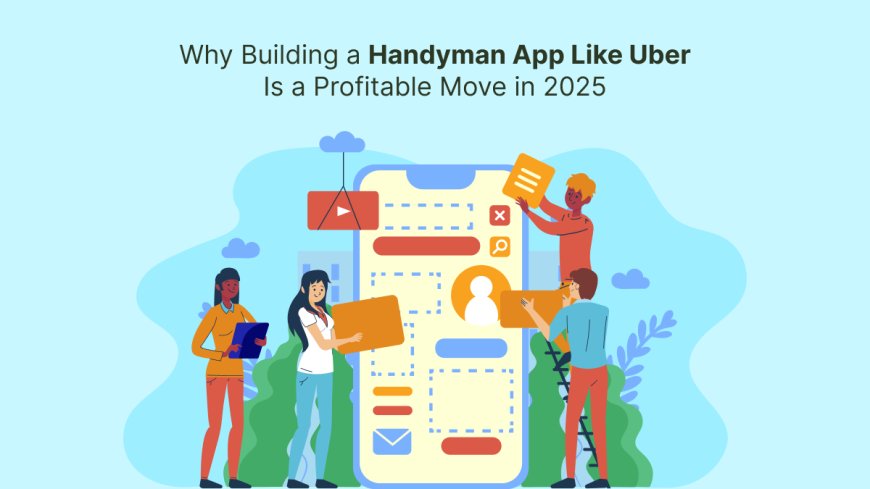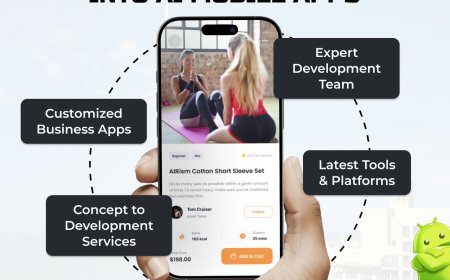Why Building a Handyman App Like Uber Is a Profitable Move in 2025
Discover why handyman apps like Uber are in demand and how launching one in 2025 can unlock recurring revenue and long-term growth.

In 2025, the demand for quick, on-demand services continues to soarand handyman services are no exception. From plumbing to furniture assembly, todays consumers prefer booking service providers via a mobile app instead of calling around or waiting days for help. Thats exactly why building ahandyman app like Uber is not just timelyits profitable.
In this guide, well break down why the handyman app space is booming, the essential features your app needs, how monetization works, and how a white-label handyman clone solution can fast-track your success.
The Rise of On-Demand Handyman Apps
The handyman services market has been traditionally fragmented. Local technicians often depend on word-of-mouth marketing and operate with limited digital presence. However, the Uberization of services is changing that rapidly. Apps like UrbanClap (now Urban Company), TaskRabbit, and Handy have shown that customers prefer organized, vetted platforms that ensure quality service, transparent pricing, and convenience.
In 2025, consumers now expect:
- Instant booking
- Real-time tracking
- Verified professionals
- Digital payments
For startups and enterprises, this shift represents a massive opportunity to create a branded platform that solves common pain points in service delivery.
Why Its Profitable in 2025
1. Rising Demand Across Urban and Semi-Urban Areas
Whether in metro cities or Tier 2 markets, people are willing to pay for convenience. Homeowners and renters alike seek professionals for recurring and one-time tasks like repairs, installations, cleaning, and maintenance.
With growing real estate development and a more mobile population, demand for reliable handyman services is expanding beyond big cities.
2. Low Operational Overheads
Unlike logistics or ride-hailing, handyman businesses dont need to invest in fleets or inventory. You connect customers with skilled professionals already equipped to perform the job. The platform acts as a marketplace, drastically lowering capital expenses and operational overhead.
3. Repeat Business Opportunities
Home repairs and maintenance are often recurring. Once customers trust your platform, theyre likely to come back for more services. This leads to high customer lifetime value (CLV), making your business more sustainable.
4. Multiple Revenue Streams
With the right monetization strategy, a handyman app like Uber can generate income from:
- Service commissions
- Subscription plans for vendors or customers
- In-app advertisements
- Featured listings
- Urgency-based pricing
Well explore monetization deeper in the next section.
Key Features of a Handyman App Like Uber
To succeed in the market, your app must deliver both ease of use and backend control. Below are essential modules:
For Customers:
- Simple Booking Process
Let users select services, schedule timings, and book with minimal clicks. - Real-Time Tracking
Customers can track professional arrival and job status. - Ratings & Reviews
Feedback helps build trust and service quality. - Multiple Payment Options
Include credit cards, wallets, UPI, and cash-on-delivery support.
For Service Providers:
- Profile Management
Allow professionals to list services, pricing, availability, and qualifications. - Job Alerts & Accept/Reject Feature
Pros receive real-time job requests and can accept based on availability. - Earnings Dashboard
Transparent tracking of completed jobs and revenue. - In-App Chat
Seamless communication with clients for smoother coordination.
For Admins:
- Service Category Management
Easily update categories and pricing from the backend. - Commission Control
Define commission rates per service or provider type. - Analytics Dashboard
Track revenue, active users, retention, and operational efficiency. - Support Management
Built-in support features to handle disputes and feedback.
Business Models That Work
Depending on your target region and investment capacity, you can choose from several operational models:
1. Single Vendor Model
Best for established handyman businesses wanting to digitize. All bookings go through one brand.
2. Multi-Vendor Marketplace
Great for startups aiming to aggregate multiple service providers. You earn commission on every transaction.
3. Franchise Model
License your platform to local businesses in different regions, earning from setup fees and a share of revenue.
4. Subscription-Based
Offer service plans to users (e.g., monthly home maintenance packages) for steady recurring revenue.
Read More: The Ultimate Guide to Building a Handyman App Like Uber
Speed Up Development with White-Label Handyman App Solutions
Building a handyman app from scratch is time-consuming and expensive. From backend systems to UI/UX design and QA testing, it could take 6 to 12 months with a high burn rate.
But with a white-label handyman clone app, you can:
- Launch in 2 to 4 weeks
- Save 60-70% in development costs
- Customize branding and features
- Get pre-built customer, provider, and admin panels
- Scale fast with integrated analytics and automation tools
Whether you're a startup or an established service provider, this approach minimizes technical overhead so you can focus on growth.
Monetization Strategies for Higher Profits
To turn your handyman app into a revenue-generating machine, implement these monetization models:
- Commission per booking (e.g., 1020%)
- Priority listings for service providers
- Subscription plans for premium users
- Ad placements inside the app
- Emergency/fast-service charges
- Vendor onboarding/setup fees
These streams not only diversify your income but also improve app engagement.
Steps to Launch Your Handyman App
Heres a simplified roadmap:
- Choose Your Business Model Single vendor or marketplace?
- Select a White-Label Solution Provider Evaluate based on features, scalability, and support.
- Customize Branding Logo, UI colors, and service flow.
- Integrate Payment Gateways & APIs For real-time tracking and notifications.
- Test and Deploy Run tests across devices and user flows.
- Market Aggressively SEO, social media, local advertising, and referral programs.
Conclusion
In 2025, launching a handyman app like Uber is no longer an ambitious projectits a highly strategic, profitable move. With on demand app development services and a white-label clone solution, you can enter the market quickly, serve customers efficiently, and scale your operations without technical hurdles. From reduced development costs to multiple revenue channels, this is the right time for startups and enterprises to invest in a handyman app and dominate local service markets.
FAQs
How long does it take to launch a handyman app like Uber?
With a white-label clone app solution, you can go live in 2 to 4 weeks.
Can I customize the design and features?
Yes. You can fully customize the apps UI, service categories, workflows, and branding to match your business goals and target market.
How do handyman apps make money?
Revenue is generated via commissions on services, in-app advertisements, subscription plans for providers, and surcharges for urgent bookings.
Do service providers need to be verified?
Yes. You can implement a verification and onboarding system that includes ID verification, background checks, and admin approvals for quality assurance.
Is this model suitable for Tier 2 and Tier 3 cities?
Absolutely. Smaller cities are experiencing growing demand for structured on-demand services and offer significant untapped business potential.













































